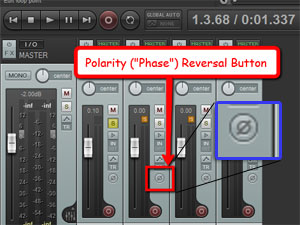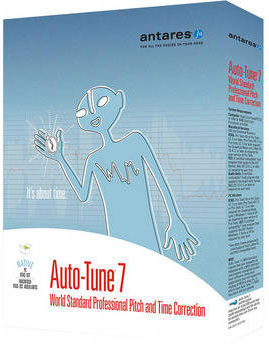 Most mixers have a switch on each channel that will reverse the polarity (often referred to as “phase,” which is not technically correct). To understand polarity, remember that sound happens in waves caused by air moving back and forth – away and toward a microphone. When a blast of air comes toward a microphone, a positive bit of air pressure is picked up. When, an instant later, the wave moves back away from the mic, you get negative pressure picked up. What the polarity switch does is flip them – a positive pressure becomes negative, and vice versa.
Most mixers have a switch on each channel that will reverse the polarity (often referred to as “phase,” which is not technically correct). To understand polarity, remember that sound happens in waves caused by air moving back and forth – away and toward a microphone. When a blast of air comes toward a microphone, a positive bit of air pressure is picked up. When, an instant later, the wave moves back away from the mic, you get negative pressure picked up. What the polarity switch does is flip them – a positive pressure becomes negative, and vice versa.
One very common use for this switch is when you use 2 mics on a snare drum, one on the top and one on the bottom. When the snare drum is hit, the skin moves in and away from a mic that is pointing at the top drum skin – a negative polarity. That same hit causes the bottom head to move outward – toward the bottom mic – a positive pressure. When these two bits of sound wave are put together in the speakers, one will push the speaker out and one will suck it in. So certain frequencies will be negated in that transaction. So it’s almost automatic for mix and live engineers to flip the polarity on the bottom mic so that the drum hit causes both heads to be negative and they will add together instead of subtract audio. This usually results in a better sounding drum with more low-frequency punch.
In this article by Dave Rat, he talks about the use of the polarity switch – when to reverse it and when not to – in order to get a great drum kit sound. Though it is in the “Live Sound” section of the Pro Sound Web Site), the article doesn’t mention it explicitly, but since he mentions the polarity in conjunction with drum monitor speakers, it’s pretty clear he’s talking about the drums in a live music situation. See the full article below:
Article for polarity for drums
Archives for December 2012
Keeping The Electric Guitar Out Of The Way Of The Vocal
 In a rock song, you want powerful and up-front electric guitar – that’s what rock is all about, right? Unfortunately electric guitars and voices usually occupy the same spot on the frequency spectrum around 3 KHz. So the guitar often overpowers the vocal. Well, when we’re mixing, if we want to turn one thing down in relation to another (that’s what mixing is all about, right?), we can just move a slider on, say, the guitar track until it’s low enough that the vocal can be heard clearly. The only problem is that by the time you get a clear vocal all the way through the song, you’ve turned the guitar down too much for it to be punchy and powerful.
In a rock song, you want powerful and up-front electric guitar – that’s what rock is all about, right? Unfortunately electric guitars and voices usually occupy the same spot on the frequency spectrum around 3 KHz. So the guitar often overpowers the vocal. Well, when we’re mixing, if we want to turn one thing down in relation to another (that’s what mixing is all about, right?), we can just move a slider on, say, the guitar track until it’s low enough that the vocal can be heard clearly. The only problem is that by the time you get a clear vocal all the way through the song, you’ve turned the guitar down too much for it to be punchy and powerful.
Of course you can use EQ to reduce the guitar’s frequency at around 3 KHz, which will help. But what if that isn’t enough? It often isn’t. Well that is where “ducking” comes in (which can be used for any and all instruments – not just guitar of course). See my article on ducking here: What is Ducking In Audio Recording?, where I show you how to do ducking in Reaper recording software. This technique uses a compressor to automatically push down the level of the guitar (or any instrument track), but ONLY when the singer is singing. You could do this manually if you are very, very patient. I highlighted an article earlier this week showing you in a video how to do this in Making The Vocal Track Sit Well In The Mix .
Here is an article by Bjorgvin Benediktsson, complete with audio examples, that talks about “side-chain” compression (the way you make ducking happen) to get the guitar out of the way of the vocal in a rock mix:
http://audio.tutsplus.com/tutorials/production/how-to-use-side-chain-compression-to-make-rock-guitars-stay-out-of-the-vocals-way/
Using Stereo On Live Performance Speakers?
Since stereo sounds so good on recorded music – we wouldn’t THINK about not creating a stereo mix for recordings – it seems like we should also try for stereo when playing live, right? Well that may or may not be true. But if you think about it, recorded music is almost always listened to when were are close to, and between both speakers – in headphones, over car speakers, on docking stations, home entertainment centers, etc. But at a live concert, there will be folks NOT between the speakers at all, so they might only be able to hear the stuff mixed into one of the L/R channels (not good).
Here’s an article that talks about the pros and cons of trying to use stereo for live sound.
Some Important Tips For Mixing Music
 There are as many tips for mixing music as there are people who mix music, but a few of these tips are common to just about anyone who has spent any significant time mixing. Joe Gilder just put out an article about the mixing lessons that were most significant to him in 2012, and not surprisingly, some of these universal mixing tips were on there.
There are as many tips for mixing music as there are people who mix music, but a few of these tips are common to just about anyone who has spent any significant time mixing. Joe Gilder just put out an article about the mixing lessons that were most significant to him in 2012, and not surprisingly, some of these universal mixing tips were on there.
One of the items on his list – the mix is slave to the recording – could be the most important lesson in his list, and was interestingly, the topic of the post I wrote yesterday – A Lack Of Passion In A Performance Can’t Be Fixed By Effects, But… which states that it is far better to get good tones, levels and performances while in the recording stage that it is to try to fix them in the mixing/editing stage.
Another of Joe’s tips is something I always, always, always (getting the idea?) do, and that is to test your mix on crappy speakers. In my case I usually do this in the car while driving around in traffic, where a good chunk of my audience will be listening to my music. The point of this is to ensure a portable mix, one that sounds good on any system it’s played on. If your mix has flaws, these crappy speakers will often highlight them better than your “good” speakers. This is doubly important if you do your mixing and mastering in a less-than-perfect acoustic space.
For the rest of the tips on Joe’s list, see his article here:
http://www.homestudiocorner.com/2012-lessons/
A Lack Of Passion In A Performance Can't Be Fixed By Effects, But…
 There’s something every recording engineer thinks about as they are tracking (recording) musicians doing their thing. That is “should I have them do it again or can I fix it in the mix?” In a perfect world, if we heard something not exactly perfect (a drummer bit off beat or a singer bit out of tune), we’d definitely have them do it again. But time and money, not to mention the attitude of the performer, are all issues that need to be considered. Luckily, there are tons of things that CAN be fixed in the mix, which is another way of saying corrected after-the-fact – usually by means of effects like compression, tempo correction and vocal tuning.
There’s something every recording engineer thinks about as they are tracking (recording) musicians doing their thing. That is “should I have them do it again or can I fix it in the mix?” In a perfect world, if we heard something not exactly perfect (a drummer bit off beat or a singer bit out of tune), we’d definitely have them do it again. But time and money, not to mention the attitude of the performer, are all issues that need to be considered. Luckily, there are tons of things that CAN be fixed in the mix, which is another way of saying corrected after-the-fact – usually by means of effects like compression, tempo correction and vocal tuning.
I read an article by Graham Cochrane this morning that basically says yes, you can fix a lot things in the mix, but passion in a performance isn’t one of them. His point is that effects plugins like a vocal tuning program can’t fix a passionless performance. You absolutely need to get that right BEFORE the mix stage. So the basic message is that effects are no help here. Graham does say that as the engineer, he can be made more comfortable knowing exactly what CAN be fixed in the mix by effects if he hears those things happen while he’s recording.
But I think there’s one thing Graham is not considering here. I believe that an understanding by the performer of what can and cannot be fixed in the mix can also free them up to be more relaxed and give a great performance. I’ve seen it over and over, especially among singers who made recordings before the prevalence of Auto-Tune. Back in the day, if a singer had a particularly challenging note, they would get very nervous before having to sing that part when recording. That tightness actually made it more difficult to get that note right. So after multiple takes, the singer would be extremely careful to hit the darned note, over-focusing on the pitch or tone and not really caring about the passion of the performance.

But then along came Auto-Tune. First, let me state that I think Auto-Tune (and other tuning programs) is way over-used in pop and country top 40 recordings. You shouldn’t just automatically snap every note to the grid the way so many producers do these days. But you can read about my thoughts on the proper use of Auto-Tune in my article – Auto-Tune – Any Tool Can Be Abused. The point is this – singers started to loosen up and worry a lot less about getting the pitch exactly right during the recording when they knew that it could be corrected in the mix! The existence of the effect plugin actually improved the quality of the performance, allowing a more relaxed and passionate delivery.
So though I agree with what Graham is saying in his article – you can’t add passion back into a flat performance with an effect plugin – I think it is worth noting that an effect plugin can make it more likely that you’ll get a passionate performance in the first place. We come full-circle:).
Here is Graham’s article: http://therecordingrevolution.com/2012/12/03/one-thing-plugins-cant-fix/
http://therecordingrevolution.com/2012/12/03/one-thing-plugins-cant-fix/http://therecordingrevolution.com/2012/12/03/one-thing-plugins-cant-fix/